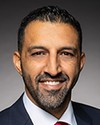Thank you, Mr. Chair.
Thank you to the entire committee for the invitation to appear before you as part of this study on the Trans Mountain expansion project.
I've worked at Environmental Defence for the last five years and have been tracking the TMX project over this time. My comments will touch on the climate and environmental impacts of the project; the amount of public financial support that has already been wasted, with more at stake; the importance of not off-loading this project and all of its financial risks onto indigenous communities; and the connection to petrochemical and plastic production in China.
The expanded Trans Mountain pipeline has the potential to deliver an additional 590,000 barrels of oil per day. Each barrel of oil we export through TMX results in additional carbon in the atmosphere, which is contributing to the unnatural wildfires, floods and droughts being experienced by so many across Canada, including the fire that burned down much of Jasper.
Producing and burning 600,000 barrels of oil would result in 84 million tonnes of carbon dioxide each year. That's the equivalent of driving around 20 million cars or running 22 coal plants. It's more than the yearly emissions of Quebec.
According to the Government of Canada's own social cost of carbon calculations, which calculates all of the costs of carbon pollution such as costs on health care, property damage and decreased agricultural productivity, the cost of that much carbon pollution would be over $20 billion a year.
The TMX expansion has already led to an increase in oil production in Alberta. The Intergovernmental Panel on Climate Change has been very clear that even existing levels of fossil fuel production will cause us to exceed 1.5°C of warming, beyond which we know the impacts of the climate crisis will become catastrophic and irreversible. Growing production of fossil fuels in a climate crisis is irresponsible to present and future generations.
That increased production also comes with environmental and social impacts, including the clearing of the boreal forest, the infringement of indigenous treaty and inherent rights and the increased health risks to first nations downstream of that production, something the federal government has recently recognized with its new study into those health impacts.
On the west coast, Vancouver tanker traffic has risen tenfold since exports started, putting endangered orca whales at risk of extinction and impacting salmon levels, which first nations communities in the area rely on. Spills, which are all too often occurrences with current pipelines, would endanger local sources of drinking water along the route and waters along the coast.
I'd like to note the link between the pipeline and plastic production in China, which contributes to global overproduction of this dangerous pollutant, which is filling our oceans, air, water, food sources and human bodies. In fact, a substantial amount of the oil exported to date has been bought by Rongsheng Petrochemical for plastics production.
Then, of course, there are the financial implications. This project has involved a huge amount of public money, an enormous fossil fuel subsidy. The federal government has provided over $35 billion in financing for TMX. That's money that taxpayers are on the hook for. The government could end up writing off most of the debt to make the pipeline appear commercially viable, which means taxpayers will have paid for the lion's share of the pipeline.
In fact, according to an analysis by TD Securities in 2018, the expansion project ceased to be viable when the project's costs exceeded $11 billion, and now they're three times that. Even if the Canadian government finds a buyer for the pipeline, it will not receive a price that covers the project costs. Current estimates are that the government would need to write off around $17 billion to $20 billion.
An eventual sale rests, in part, on the decisions around tolls—the amount the shippers are paying to use the pipeline—which are currently set at a rate below the marketplace costs of transporting the oil, given that they were based on earlier and much lower construction estimates.
Given how much the cost of building and operating the pipeline has ballooned, the tolls need to rise significantly to cover the project's full operating and capital costs. However, oil and gas companies are fighting tooth and nail against increased tolls. They don't want to pay more. They want taxpayers to pay. A decision will be made in 2025, with massive impacts on the financials of the project.
Oil companies, not taxpayers, should be paying for the pipeline of which they will be the only beneficiaries. This means the toll rate should be roughly doubled to $22 a barrel. Every penny that oil and gas companies reduce the tolls by will be paid for by the Canadian public.
The reason that this boondoggle has gone ahead is for fossil fuel companies to get a higher price for their product; it's to line the pockets of already incredibly wealthy oil executives. CNRL, Cenovus, Imperial, Suncor and MEG Energy are the only winners, while the rest of us pay the price.
Many of these companies are members of the Pathways Alliance and CAPP, which underlines the necessity of having both of these associations testify before this committee.
On a final note, it's very important that this project is not downloaded onto indigenous communities in the name of so-called economic reconciliation. TMX has massive environmental and financial liabilities, as we've explored. Furthermore, given the accelerating pace of the energy transition, this project is likely to become a stranded asset well before the end of its life. Shifting these liabilities from the public or private sectors to indigenous communities is just another form of colonial exploitation.
I'm done. I look forward to any questions.














